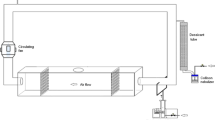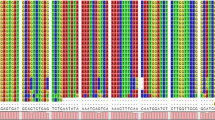Abstract
Environmental samples analyzed by quantitative PCR (qPCR) are subject to interference by inhibitors present in the environment being sampled. A controlled determination of the effect of inhibitors associated with sampling indoor air and the ability of internal standard controls to detect inhibition was carried out by filter collection of air samples followed by spiking of the filters with green fluorescent protein-expressing Aspergillus fumigatus conidia. Microscopic conidial counts were compared with qPCR results and correlated with levels of particulate matter and viable airborne microorganisms. Our data showed that PCR can be inhibited by masses of particulate matter as low as 50 μg and that the amount of inhibition was positively correlated with the mass of particulate (r = 0.75) and the number of non-filamentous organisms (r = 0.73). The use of internal standard DNA identified the presence of inhibitors and indicated the need for additional sample processing or qualification of sample results.





Similar content being viewed by others
References
Alvarez, A. J., Buttner, M. P., Toranzos, G. A., Dvorsky, E. A., Toro, A., Heikes, T. B., Mertikas-Pifer, L. E., & Stetzenbach, L. D. (1994). Use of solid-phase PCR for enhanced detection of airborne microorganisms. Applied and Environmental Microbiology, 60, 374–376.
Alvarez, A. J., Buttner, M. P., & Stetzenbach, L. D. (1995). PCR for bioaerosol monitoring: Sensitivity and environmental interference. Applied and Environmental Microbiology, 61, 3639–3644.
Breysse, P. N., Buckley, T. J., Williams, D., Beck, C. M., Jo, S. J., Merriman, B., Kanchanaraksa, S., Swartz, L. J., Callahan, K. A., Butz, A. M., Rand, C. S., Diette, G. B., Krishnan, J. A., Moseley, A. M., Curtin-Brosnan, J., Durkin, N. B., & Eggleston, P. A. (2005). Indoor exposures to air pollutants and allergens in the homes of asthmatic children in inner-city Baltimore. Environmental Research, 98, 167–176.
Burge, H. A., Pierson, D. L., Groves T. O., Strawn K. F., & Mishra S. K. (2000). Dynamics of airborne fungal populations in a large office building. Current Microbiology, 40, 10–16.
Costa, C., Vidaud, D., Olivi, M., Bart-Delabesse, E., Vidaud, M., & Bretagne, S. (2001). Development of two real-time quantitative TaqMan PCR assays to detect circulating Aspergillus fumigatus DNA in serum. Journal of Microbiological Methods, 44, 263–269.
Courtney, B. C., Smith, M. M., & Henchal, E. A. (1999). Development of internal controls for probe-based nucleic acid diagnostic assays. Analytical Biochemistry, 270, 249–256.
Cruz-Perez, P., Buttner, M. P., & Stetzenbach, L. D. (2001). Detection and quantitation of Aspergillus fumigatus in pure culture using polymerase chain reaction. Molecular and Cellular Probes, 15, 81–88.
Griffiths, W. D., & DeCosemo, G. A. L. (1994). The assessment of bioaerosols – a critical review. Journal of Aerosol Science, 25, 1425–1458.
Haugland, R. A., Vesper, S. J., & Wymer, L. J. (1999). Quantitative measurement of Stachybotrys chartarum conidia using real time detection of PCR products with the TaqMan fluorogenic probe system. Molecular and Cellular Probes, 13, 329–340.
Keswani, J., Kashon, M. L., & Chen, B. T. (2005). Evaluation of interference to conventional and real-time PCR for detection and quantification of fungi in dust. Journal of Environmental Monitoring, 7, 311–318.
Livak, K. J., Flood, S. J., Marmaro, J., Giusti, W., & Deetz, K. (1995). Oligonucleotides with fluorescent dyes at opposite ends provide a quenched probe system useful for detecting PCR product and nucleic acid hybridization. PCR Methods and Applications, 4, 357–362.
Maher, N., Dillon, H. K., Vermund, S. H., & Unnasch, T. R. (2001). Magnetic bead capture eliminates PCR inhibitors in samples collected from the airborne environment, permitting detection of Pneumocystis carinii DNA. Applied and Environmental Microbiology, 67, 449–452.
McDevitt, J. J., Lees, P. S., Merz, W. G., & Schwab, K. J. (2004). Development of a method to detect and quantify Aspergillus fumigatus conidia by quantitative PCR for environmental air samples. Mycopathologia, 158, 325–335.
McDevitt, J. J., Lees, P. S., Merz, W. G., & Schwab, K. J. (2005). Use of green fluorescent protein-expressing Aspergillus fumigatus conidia to validate quantitative PCR analysis of air samples collected on filters. Journal of Occupational and Environmental Hygiene, 2, 633–640.
Olive, D. M. (1989). Detection of enterotoxigenic Escherichia coli after polymerase chain reaction amplification with a thermostable DNA polymerase. Journal of Clinical Microbiology, 27, 261–265.
Roe, J. D., Haugland, R. A., Vesper, S. J., & Wymer, L. J. (2001). Quantification of Stachybotrys chartarum conidia in indoor dust using real time, fluorescent probe-based detection of PCR products. Journal of Exposure Analysis and Environmental Epidemiology, 11, 12–20.
Sachadyn, P., & Kur, J. (1998). The construction and use of a PCR internal control. Molecular and Cellular Probes, 12, 259–262.
Schwab, K. J., Neill, F. H., Le Guyader, F., Estes, M. K., & Atmar, R. L. (2001). Development of a reverse transcription-PCR-DNA enzyme immunoassay for detection of “Norwalk-like” viruses and hepatitis A virus in stool and shellfish. Applied and Environmental Microbiology, 67, 742–749.
Spiess, B., Buchheidt, D., Baust, C., Skladny, H., Seifarth, W., Zeilfelder, U., Leib-Mosch, C., Morz, H., & Hehlmann, R. (2003). Development of a LightCycler PCR assay for detection and quantification of Aspergillus fumigatus DNA in clinical samples from neutropenic patients. Journal of Clinical Microbiology, 41, 1811–1818.
Wasylnka, J. A., & Moore, M. M. (2002). Uptake of Aspergillus fumigatus Conidia by phagocytic and nonphagocytic cells in vitro: quantitation using strains expressing green fluorescent protein. Infection and Immunity, 70, 3156–3163.
Wilson, I. G. (1997). Inhibition and facilitation of nucleic acid amplification. Applied and Environmental Microbiology, 63, 3741–3751.
Zhou, G., Whong, W. Z., Ong, T., & Chen, B. (2000). Development of a fungus-specific PCR assay for detecting low-level fungi in an indoor environment. Molecular and Cellular Probes, 14, 339–348.
Acknowledgements
We thank Brian Schofield, The Johns Hopkins University Bloomberg School of Public Health for assistance with the microscopy. This research was supported in part by a Johns Hopkins Center in Urban Environmental Health pilot grant (ES03818) and a Johns Hopkins NIOSH Education and Research Center Pilot Project Research Training Award (T42/CCT31049-09).
Author information
Authors and Affiliations
Corresponding author
Rights and permissions
About this article
Cite this article
McDevitt, J.J., Lees, P.S.J., Merz, W.G. et al. Inhibition of quantitative PCR analysis of fungal conidia associated with indoor air particulate matter. Aerobiologia 23, 35–45 (2007). https://doi.org/10.1007/s10453-006-9047-6
Received:
Accepted:
Published:
Issue Date:
DOI: https://doi.org/10.1007/s10453-006-9047-6




